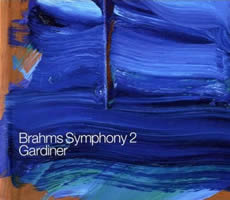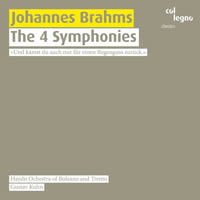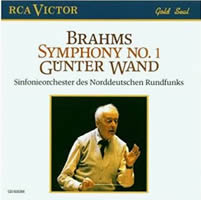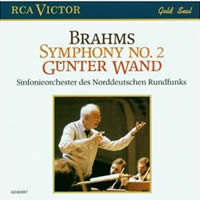Armer Brahms, prima pars
|
Dan Albertson [September 2009.] [Yes, Brahms is “poor,” or is at least treated as such. He needs a reevaluation! This survey is the beginning of a look at recent recordings of the symphonies; the next chapter will include the Third and Fourth from Sir John Eliot Gardiner and the complete cycle from Sir Simon Rattle, along with the last two symphonies in the Gustav Kuhn set. With gratitude to ‘tere Jutta,’ Jutta Lambrecht, and to Bob Morabito from the other Highland, for daring to care about my past (yes, you know the one). D.A.]
Johannes BRAHMS: Begräbnisgesang (1858)*. Felix MENDELSSOHN-BARTHOLDY: Mitten wir im Leben sind (1830)*. BRAHMS: Schicksalslied (1868-71)*; Symphony No. 1 (1855-76). The Monteverdi Choir*, Orchestre Révolutionnaire et Romantique, Sir John Eliot Gardiner (cond.). Soli Deo Gloria 702 (http://www.monteverdi.co.uk/shop). Distributed in the US by Harmonia Mundi (http://www.harmoniamundi.com/). Johannes BRAHMS: Alto Rhapsody (1869)* & **. Franz SCHUBERT: Gesang der Geister über den Wassern (1820)**. SCHUBERT arr. BRAHMS: Gruppe aus dem Tartarus, An Schwager Kronos (1871)**. BRAHMS: Symphony No. 2 (1877). Nathalie Stutzmann (alt)*, The Monteverdi Choir**, Orchestre Révolutionnaire et Romantique, Sir John Eliot Gardiner (cond.). Soli Deo Gloria 703 (http://www.monteverdi.co.uk/shop). Distributed in the US by Harmonia Mundi (http://www.harmoniamundi.com/). Johannes BRAHMS: The 4 Symphonies. Haydn Orchestra of Bolzano and Trento, Gustav Kuhn (cond.). col legno WWE 3 CD 60015 (http://www.col-legno.com/). Distributed in the US by Allegro Music (http://www.allegro-music.com/). Johannes BRAHMS: Symphony No. 1 (1855-76). NDR-Sinfonieorchester, Günter Wand (cond.). RCA Victor Gold Seal 60086-2-RG (O/P). Johannes BRAHMS: Symphony No. 2 (1877). NDR-Sinfonieorchester, Günter Wand (cond.). RCA Victor Gold Seal 60087-2-RG (O/P). The Brahms symphonies were an area that I avoided for much of my life. I equated Brahms with tradition and sterility. As with many prejudices, a closer examination showed the error of my ways. The period-instrument recordings of Sir John Eliot Gardiner spurred my most recent engagement with this quartet by placing the symphonies alongside other music by Brahms or his forebears. The simultaneous appearance on the new-music label col legno of the symphonies compelled me to retreat to my vault for the only complete set I had maintained, a 1980s cycle. 1 certainly boasts an imposing opening, and Wand starts at a propulsive rate and seldom relents. What I once admired in his performance, its directness and simplicity, now seems to lack nuance. I retain an affection for its clarity, achieved despite using modern instruments and many more strings than he should. This approach seems too strict, while that of Kuhn seems too airy and relaxed, veering more toward bathos than pathos. Gardiner finds a comfortable middle way, with much of Wand’s propulsion but tempered when necessary, most of all for the oboe cantilena. The second and third movements are given similar treatments by all three maestri, but the period instruments of Gardiner give the music a warmth that neither Kuhn nor Wand can muster. The finale again brings tempi back into the equation and though his duration is the quickest, Gardiner again employs gradations to much greater effect. Pulse is such an innate, subjective matter, yet his seems the truest and his performance is also the clearest and most “live” (which it is!), with a true verve. A few string passages come off as shrill in the recording and the brass, elsewhere balanced well, seem too far back in the closing pages, but such minutiae are easily forgiven. Another great feature of the Gardiner recording are three convincing live performances from Paris in the autumn of 2007, placing Brahms in the context that his music deserves and requires for fuller comprehension. Kuhn, aware of the HIP movement, has reduced his strings, but for some reason the recorded sound makes the string body seem plodding and thick, with little definition to soli. The recording, in general, seems mediocre or poor, spacious when not muddy. His finale has its all-important timpani strokes clouded and the brass are downright nonexistent compared to those of Gardiner. Brahms: Symphony No. 1 (1855-76)
2 has an enormous opening movement, one that requires deft conducting to hold together its rambling nature. Again Wand starts off on fire and he may be the best at presenting the movement in its most cogent state. He again lacks subtlety, however, and his pulse seems too rigid. Yes, I am a clock-watcher, but only when the music is palpably too fast or too slow. Kuhn is a minute slower than Gardiner, who is four minutes slower than Wand. The big difference is the pacing accomplished by Gardiner; Kuhn is content to let the detours perambulate for no reason, never bringing any cohesion or tension to the movement’s varied moods. As the symphony progresses, Wand seems more and more nonchalant, though in a curious way I am again drawn to this detachment and stoicism. Hearing the richness of Gardiner in comparison, however, makes me doubt the Wand approach. Kuhn’s 2 is too rhapsodic and too restrained, never producing any spark. Again Gardiner provides much more than the symphony, and the performance of the Alto Rhapsody by the superb Nathalie Stutzmann would be reason enough to buy the disc. The ORR’s accompaniment to her assured voice is positively electric. A different world is to be heard in the Gesang for male voices, pairs of violas and celli and double bass, a dark work unique in Schubert’s canon and in Brahms’ loving arrangements from 1871 of two Schubert Lieder, showing the versatility of the singers and orchestra alike. Brahms: Symphony No. 2 (1877)
For the music itself, Gardiner is most compelling, with Kuhn marred by troublesome sound and disengaged performances, and Wand’s complete recording showing its age. Gardiner’s notes are far superior, as well; Kuhn’s border on the absurd and fanciful (more information in secunda pars), whereas Gardiner is his usual scholarly self, in conversation with the composer Hugh Wood and on his own in Brahms: Roots and memory. One learns, for instance, how he has meticulously referred to the scores of Fritz Steinbach and his pupil Walter Blume, with Steinbach being Brahms’ preferred Dirigent. Such an exercise would be purely academic if the results were not audible, but they clearly are, most of all in the rhythmic precision, and I am eager to hear his 3 and 4.
[More Dan Albertson]
[More
Brahms]
[Previous Article:
Album Tweets 2.]
[Next Article:
Tome Tweets 1.]
|




